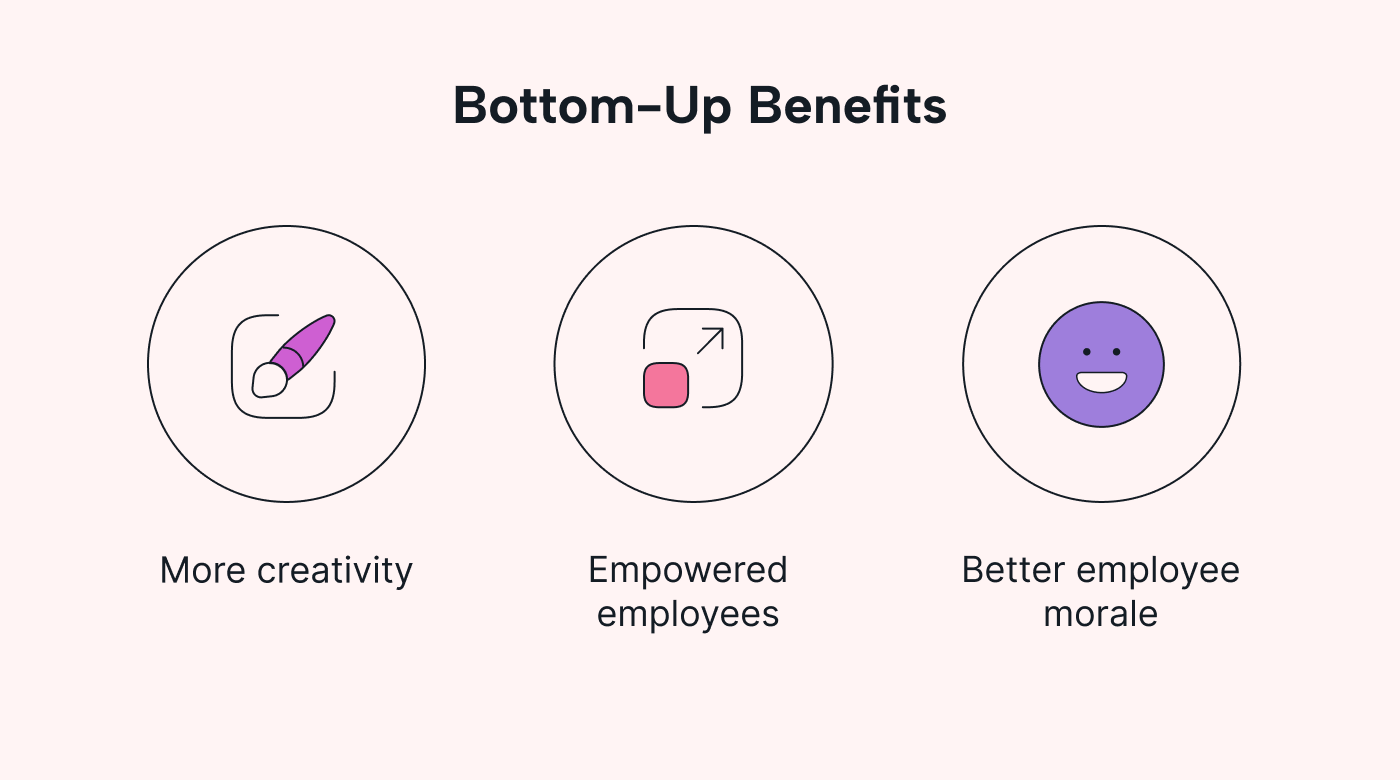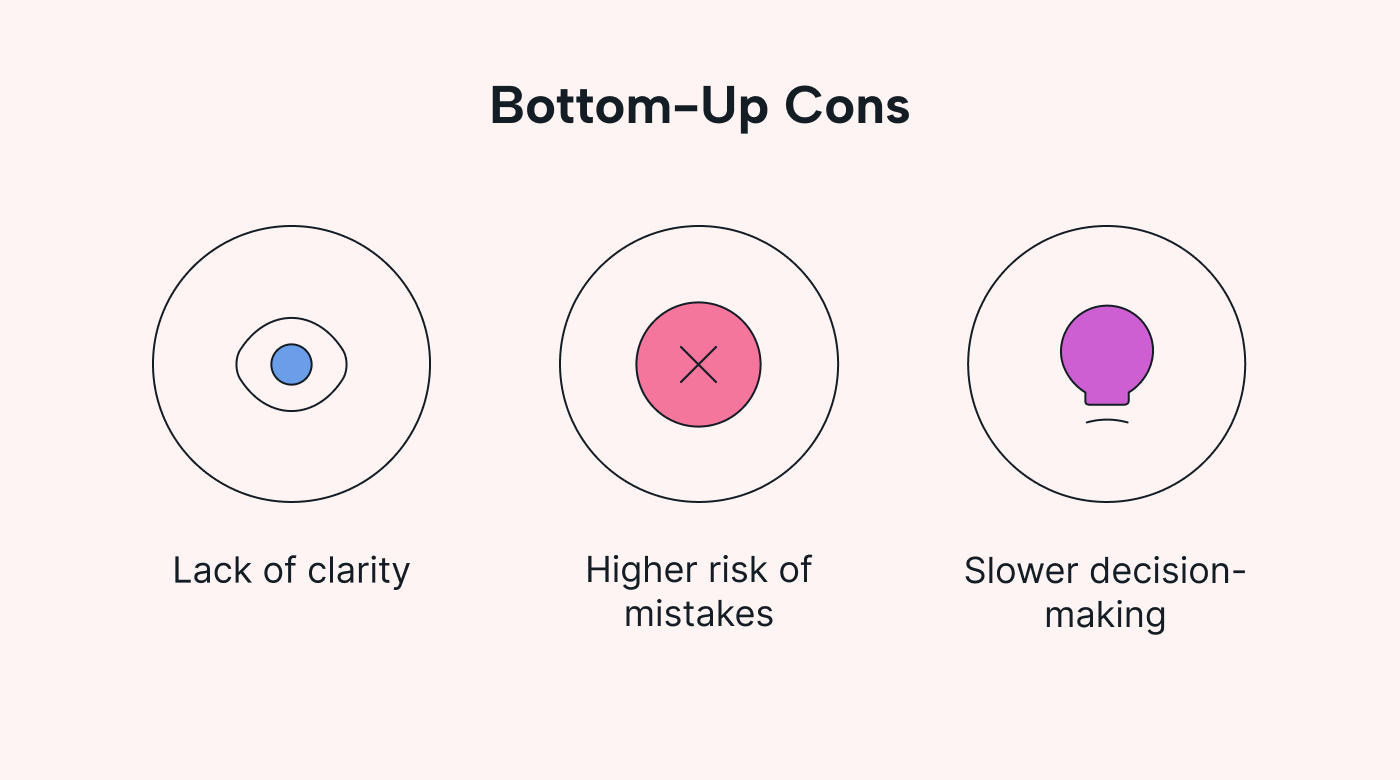To maximize company performance, you must invest in your people. As Howard Schultz, founder of Starbucks, once said,
“People want guidance, not rhetoric. They want to be given the responsibility to help solve the problem and the authority to act on it.”
That quote does a good job of expressing a management style known as bottom-up.
The purpose of a bottom-up approach to team management is to offer employees a sense of responsibility. This method gives them a voice, making them feel more valued in the company and therefore invested in its outcomes.
The bottom-up management approach is generally used to improve employee morale. It’s also valued for the creativity it brings to the workplace. This article will cover everything you need to know about this management method to help you decide if it would be a good fit for your company culture.
What is the bottom-up approach in team management?
The bottom-up approach to team collaboration involves employees across all departments having a say in business goals and responsibilities. Under this team management style, you take into account all of your team’s ideas and perspectives before your company’s executives make the final business decision.
This approach provides your team with more autonomy over how they’d like to work, and it also empowers employees, regardless of their position in the company. It’s a way of giving people a voice and helping them feel that their opinions matter in the workplace.
The bottom-up approach is also flexible, favoring creativity and discussions around new ideas.
“Employees want to grow personally and professionally,” says Julian Hamood, President at Trusted Tech Team, in a discussion with Forbes magazine. “Therefore, allowing them to influence decisions that affect their work and the organization’s direction will create a collaborative environment and ensure mutual buy-in on the mission.”
A great example of the bottom-up approach in team management is journalism.
It’s up to the journalists to come up with fresh ideas for content before getting their editors’ approval. The bottom-up model is very effective here because it’s the journalists who know what’s going on in their niche better than anyone.
They have the creativity and knowledge, so their input is valuable. They’ll also be able to produce better work when they have a say in what they’re writing about.
3 benefits of the bottom-up approach
It pays to give your employees a voice and consider their ideas about how things should go within your company. Here’s how a bottom-up approach helps teams make better business decisions and can improve company performance:
 |
1. More creativity
Under a bottom-up system, you encourage employees to find creative solutions to your company’s challenges. Since you’ll be getting the ideas of everyone on your team, you’ll have plenty of fresh perspectives that could potentially blossom into something big for your company.
2. More empowered employees
Company leaders should empower their employees, as this will help create a company culture that attracts quality talent and retains existing workers.
One of the ways leaders can do this is simply by listening to their employees’ concerns and ideas. Employees who feel their voices are heard are 4.6x more likely to feel empowered to perform their best possible work.
Under the bottom-up style of team management, each employee gets to contribute their ideas on what your company should work on to satisfy more customers. It’s not just the executives or higher-ups in the company that get to call the shots.
3. Improved employee morale
Optimizing employee engagement is essential to keeping your workforce happy — and, ultimately, retained. However, research by Gallup shows that 65% of U.S. employees don’t feel engaged in their workplace.
Giving them a bigger voice in the workplace can help employees feel like important members of our organization. This, in turn, makes them valuable and improves their morale.
Research from Frontiers in Psychology shows that a bottom-up approach has a significant impact on satisfaction and overall work engagement.
3 disadvantages of the bottom-up approach
Employees who feel more engaged and empowered and a work environment that encourages creativity are positive things. That said, a bottom-up approach does come with limitations and obstacles. We’ll discuss three of them below.
 |
1. Lack of clarity
When multiple employees share many ideas at the same time, it can be difficult for management to agree on which one to use.
Additionally, executives have insights into the business, such as the company budget, revenue forecasting, and expenses, that lower-level employees simply don’t have. And these factors have a significant influence on business decisions.
One way to overcome this problem is to invite executives into your employees’ brainstorming sessions. While it’s important that your employees’ ideas remain the focus of the conversation, having the executives there to provide feedback will help guide the discussion and ensure clarity for all.
2. Higher risk of mistakes
The bottom-up approach to team management comes with a higher risk of mistakes. For example, new, inexperienced hires may not have the insight needed to make excellent business decisions.
3. Slower decision-making
Deciding which goals to focus on can take longer with a bottom-up approach. Also, the implementation of any change is often slower since there are multiple people involved.
At the same time, employees may run into disagreements over ideas, which can slow down the decision-making process even further. This can lead to reduced productivity and even hurt collaboration in the workplace.
Which businesses can benefit from the bottom-up approach?
The types of businesses that can particularly benefit from the bottom-up approach in team management include the following:
Software companies
Software companies can benefit from the bottom-up approach to step up their operations. For example, if teams are working on new features to implement in a product to improve customer satisfaction, having input from the bottom up will drive smarter decisions.
For instance, customer support reps have a solid understanding of customers’ wants and needs. After all, they’re at the forefront of customer interaction and receive feedback from customers that managers don’t.
Second, software engineers are experts in all of the product’s technical aspects. They know what’s possible, and their expertise can help guide the development process.
Marketing agencies
There are different components to a marketing team, each with important tasks and roles. These can include content marketers, graphic designers, social media managers, and PR specialists.
Creativity plays an important role in marketing, as your team needs to brainstorm new ways to engage and attract customers’ attention. A bottom-up approach helps the team align on what will retain customers and deliver the best possible experience for them.
Sales teams
Salespeople talk to customers every single day, listening to them and learning more about their needs so they can land more and better deals. As a result, they have insightful information on customers that could provide direction on what you can improve in your service, product, or even sales process.
How to know if a bottom-up approach is the right fit for your company
Wondering if it’s time to switch to a bottom-up approach in your company? Here are some signs that your business could benefit from adopting a bottom-up approach to team management:
 |
Your company has a high employee turnover rate
Retaining employees is a major challenge for many companies across the U.S. More than 4 million American employees quit their jobs between July and November 2022.
If you feel like you’re losing too many employees too fast, it’s time to change things up by switching to a bottom-up approach. This will give your employees more power and control over what goes on within your company, improving their satisfaction and making them less likely to leave as a result.
“If you want to retain smart, talented people, you need to let them make decisions,” says Alp Bora, CEO of Alp Bora & Co, in an article for Forbes. “People want to have skin in the game—get them on board with the decision-making so they see how their work impacts the outcome. Let them influence the outcome so they become the future leaders of your organization.”
Your customer satisfaction rate is low
Are your customers showing signs of low satisfaction? If so, then it might be time to give your employees more involvement in the decision-making process.
Since employees are the ones who typically engage with customers the most, they have insights about your audience that executives may not have. Your employees can collect customer feedback via the following methods to better understand customers’ opinions about your brand:
- Customer surveys: Employees can send surveys to your audience with specific questions on their brand experience. Your team can then filter through these responses, focusing on repeat complaints.
- Customer interviews: During customer interviews, your employees can ask direct questions about customers’ needs and preferences. They can even record these sessions and share them with upper management to review.
- Customer tickets: Customer tickets can be a goldmine when it comes to collecting customer feedback. You can use them to identify common complaints that customers have about your brand and find ways to improve their experience.
You’re in the process of a brand refresh
If you don’t actively adapt to customers’ changing expectations, you’ll be left behind. A brand refresh allows you to reassess your company mission and how you service customers so that you can keep up with the times.
During a brand refresh, you’ll change every part of your strategy, including your marketing, customer support, and product features. Adopting a bottom-up approach during this time can be very helpful since your whole team can offer their input.
What is the top-down approach in team management?
Under the top-down approach, the main executive leaders of the company make the decisions and then delegate specific tasks to lower-level employees. The executives must identify a core goal, then work all the way down to determine the actions necessary to achieve it.
 |
Benefits of the top-down approach include less business risk, more organization, and faster decision-making. Essentially, you’re leveraging the executives’ expertise and experience to lead your company.
Disadvantages of the top-down approach include less creativity, reduced employee morale, and possible misunderstandings in terms of expectations between leaders and employees. This approach also creates a power imbalance in the workplace that might feel unfair to employees.
A bottom-up approach will empower your team
A bottom-up approach to team management gives your team a voice in company decisions and helps them feel more valued. It can improve not only your company’s performance but also your team members’ engagement.
To get started with the bottom-up approach, start by running a survey with your employees to get an idea of how they’re feeling. What would they like to see within your company? What types of support do they need to work more effectively and meet your company goals?
To take your team management to the next level, try Motion for free for7 days. Sign up to get access to all of Motion’s features and start empowering your team today!





